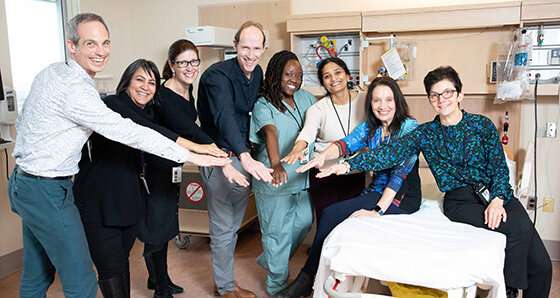QuILT study reveals systemic barriers to safe patient transfers in labor and delivery

Delivering a baby is one of life's most thrilling and nerve-racking experiences. Whether someone is about to become a first-time parent or they have young ones at home already, most families have a host of questions before, during and after delivery. The Obstetrics and Gynecology team at St. Michael's Hospital is committed to making sure people have the answers they need and that parents have excellent care and support throughout their pregnancy.
But as a multi-disciplinary team, how do different practitioners ensure smooth communication and collaboration between themselves to enable a safe and positive experience during labor and delivery?
That's the question that researchers from the Applied Education Research Operative (AERO) set out to answer as part of a project known as Quality Improvement in Labor and Delivery Transfers (QuILT).
Led by AERO scientists Drs. Stella Ng, Ryan Brydges and Doug Campbell and supported by Research Coordinator Lori Nemoy, QuILT brought family doctors, midwives, nurses, obstetricians and other clinicians together with education researchers to tackle a common challenge: how to safely and respectfully complete transfers of care and consults on St. Michael's Labour and Delivery unit.
This was a change-oriented research project that required input from dozens of people across multiple disciplines.
"We started with the clinician champions on the unit to help inform the direction of the study. Their input and expertise was invaluable. When we started recruitment, however, we quickly realized that they could not speak for everyone in their profession and we weren't getting the buy-in we hoped for. That was an important early lesson for us," explained Nemoy.
The researchers started engaging all participants in an open and inclusive process, earning their trust by hearing and respecting individual perspectives as important guidance toward the study's success.
"We worked with each group through consultation and conversation, in their unique settings with their own teams, to help maximize comfort and engagement with the project," said Dr. Brydges.
They used a powerful approach called institutional ethnography to map work processes and identify opportunities for change. The QuILT team gathered data that helped them design key project outcomes: simulation-based education to support quality improvement and inform policy changes on the unit.
The major outcome of institutional ethnography is a map that outlines the processes and tension points in the system that drive people's workplace behaviors. In particular, the map highlights how points of disjuncture are areas for constructive change.
"One of the benefits of institutional ethnography is that it positions the work processes as the focus of the research study. It's not about people's individual errors or challenges but rather about the way people are coordinated by forces beyond their control, such as ingrained policies and protocols," said Dr. Ng.
"It allows disparate people with different interests to come together to look at how systemic structures are orchestrating their work in ways that are unhelpful to them. It empowers people to say, "I have a chance to fix this broken piece of our system.'"
By observing and talking to physicians, midwives and nursing staff, the researchers found clues that revealed how these deeply-entrenched policies and structures were contributing to communication breakdowns between professions and, at times, disjointed transfers of care for patients.
"We liken it to "The Matrix." We make things that seem invisible, visible again. Once we can see the issues, we can start to fix them," said Dr. Brydges.
With the institutional ethnography map developed, table-top simulation scenarios designed, and research completed, the practitioners on the Labour and Delivery unit now have an opportunity to spread the knowledge revealed through the QuILT study.
"This type of study is meant to produce qualitative outcomes. We aren't going to measure its success on metrics such as a reduction in critical incidents. The success measures lie in the impact stories. How are the project champions able to change their practices? How can they tap others to make changes, how can they tackle policy changes?" said Dr. Brydges.
Ultimately, QuILT took the team's experience in education science and clinical education and blended it with a quality improvement challenge. Those involved now understand how the system can be shifted to improve the quality of patient care and the quality of education on the unit.















